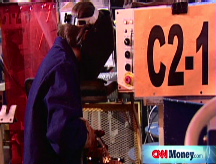Manufacturing still weak, employment drops
Index of purchasing managers unchanged in April, beating economists' forecasts, but employment index drops off to lowest level in nearly 5 years.
NEW YORK (CNNMoney.com) -- A key index of manufacturing activity was unchanged at a weak level in April, with employment in the sector falling dramatically to the lowest point in nearly 5 years, according to a survey of purchasing managers released Thursday.
The Institute for Supply Management's (ISM) manufacturing index stayed at the March reading of 48.6. Economists were expecting a reading of 48, according to a consensus estimate compiled by Briefing.com.
The tipping point for the index is 50, with a reading above that reflecting growth in the sector. A reading below 50 represents a decline in manufacturing.
"Manufacturers are in a situation where both new orders and production are slowly declining, but prices continue to rise at highly inflationary rates," said the chairman of the ISM Business Survey Committee, Norbert J. Ore, in a statement.
The ISM said production rose to 49.1 from the previous month's 48.7 while new orders registered 46.5, the same reading as in March.
But the ISM prices index reached its highest level in nearly four years, rising to 84.5 in April from March's 83.5.
Purchasing managers felt the crunch of higher production costs, with 71% saying they paid higher prices in April and only 2% said prices were lower.
"The prices paid index suggests that the import prices are rising faster than manufacturers can keep up with," said Wachovia chief economist John Silvia. "Energy prices are also rising and profits are getting squeezed."
Weak employment data: The overall index was weighed down by a sharp 3.8 point drop in the group's employment index, which fell to 45.4 in April, from March's 49.2. April's reading is the lowest level since May 2003.
"When prices are high and profits are lower, there's not a lot that companies can do to adjust," said Silvia. "They are forced to cut jobs."
The weak manufacturing employment numbers come after an earlier report released by the U.S. Labor Department that showed the number of newly laid off Americans filing for unemployment benefits spiked higher than economists' predictions. And Friday will bring a glimpse at April employment; the unemployment rate was 5.1% in March.
"It's entirely possible that given these numbers, the unemployment rate could go to 5.2% from 5.1%," said Silvia, who noted that Wachovia increased its estimate of total jobs lost in April by 10,000 to 20,000 based on the report.
"Not only will we see a rise in total unemployment, but we will also see a sharp rise in unemployment in the production sector for April," he said
Indicates some economic growth: April marked the third consecutive month in which the manufacturing sector failed to grow. But an index reading over 41.1 historically indicates that the overall economy is growing, according to ISM. Accordingly, ISM estimates that a 48.6 reading corresponds to annualized real GDP growth of 2.4%.
Though that may not be the fast-paced growth some economists were hoping for, it is better than the 0.6% preliminary first-quarter GDP reading that the government released Wednesday. ![]()


